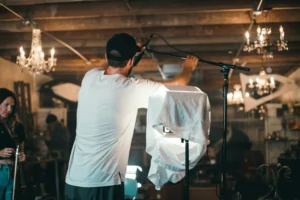What does a wrap mean in filmmaking?

Filmmaking has a vocabulary of its own, composed of technical jargon, colloquial English, and age-old customs handed down via decades of directors, performers, and crew members. Of them, “It’s a wrap” is among the most often used and honored. Whether you just appreciate behind-the-scenes documentaries or are a devoted movie buff, you have most certainly heard this phrase at some time.
But in cinema, what does “It’s a wrap” really mean? Why is set such a major event? Where, then, did it originate?
Let’s break it all down in this extensive blog article.
Understanding Filmmaking “It’s a Wrap”
At its heart, “It’s a wrap” is a statement used in the film and television business to denote that shooting for a specific scene, day, or even the whole project has officially been completed. It indicates the conclusion of a filming session, letting the actors and crew know that their job on set is done—at least for the time being.
When Is It Used?
“It’s a wrap” may be used in numerous contexts:
- Scene Wrap: When a given scene has been successfully shot.
- Daily Wrap: When the day’s planned shoot is concluded.
The principal photography wrap marks the conclusion of the film’s whole filming.
It’s often stated by the assistant director (AD), director, or production manager and is frequently followed by clapping, shouting, and occasionally even celebrations—especially if it’s the last day of filming.
The Emotional Weight of the Phrase
Though it’s a simple sentence, “It’s a wrap” contains emotional weight. For many individuals on set, hearing those words might bring a combination of relief, pride, and nostalgia. After weeks or even months of hard labor, long hours, and endless takes, closing up filming is a big milestone. For performers, it may be the final time they inhabit a role. For crew members, it represents the culmination of their technical and artistic efforts.
In reality, the final wrap of a film typically leads to wrap parties—social gatherings when the whole cast and crew celebrate the successful conclusion of the movie.
The Origins of the Phrase
The actual origin of “It’s a wrap” is debatable, although most film historians believe that the phrase goes back to the early 20th century.
One Popular Theory
A generally recognized notion is that “wrap” is an abbreviation for W.R.A.P., which stands for Wind, Reel, And Print. This refers to the last procedures required in filmmaking using standard film reels:
- Wind: The film gets rewound onto the reel.
- Reel: The footage is sorted and saved.
- Print: A tangible print is created for editing and viewing.
Although this acronym idea has a lovely ring to it, there’s no credible confirmation that this was ever an established industry phrase. More likely, the term “wrap” derives from the ordinary usage of the verb “to wrap up,” meaning to end or conclude something.
Behind the Scenes: How a Wrap Is Declared
Here’s how a wrap normally plays out on a film set:
- Last Shot Completion: The last take is successfully filmed.
- Director Approval: The director cries out, “Cut!” and certifies they have the video they need.
- Over the radio or verbally, the assistant director or unit production manager says, “That’s a wrap!”
- Celebration: The crew may cheer, yell, or even embrace one another. Certain shows have little customs or presents, including group pictures or clapping slates.
- It’s also usual for specific cast members to be “wrapped” early if their sequences end before the rest of the filming. In such circumstances, they’re given a customized farewell and maybe a tiny keepsake or present.
Wrap Culture in Modern Filmmaking
As filmmaking changes, so does wrap culture. In small films or short projects, wraps could be modest acknowledgments, but in large studio pictures, they might grow into full-on celebrations. With many performers sharing wrap-day pictures or passionate thank-you cards to their co-stars and crew, social media has elevated the custom.
Even post-production team members—editors, sound designers, VFX artists—have created their own sort of “wraps” to signal the conclusion of their work cycles. While they aren’t part of the original on-set use, the attitude of accomplishment and celebration continues.
Common Wrap Traditions
Here are a few well-known wrap traditions:
- Wrap Parties: These are held at the conclusion of filming and are generally paid for by the production company.
- Gift Exchanges: Directors or producers may provide customized gifts to actors and crew.
- Slate Signing: The film slate or clapperboard is signed by important individuals.
- Video Montages: Behind-the-scenes footage is displayed during wrap parties as an homage.
These rituals help build a feeling of camaraderie and appreciate everyone’s commitment to the project.

“It’s a Wrap” Beyond Filmmaking
Fascinatingly, the term “it’s a wrap” has evolved outside of the film industry. You’ll now hear it at business meetings, fashion shoots, music video settings, and even in ordinary conversations. It’s become a worldwide way to communicate, “We’re done here,” frequently with a tone of contentment.
5 Frequently Asked Questions (FAQs)
1. Is “It’s a wrap” the same as “cut”?
No. “Cut” is called by the director to halt shooting a take. “It’s a wrap” indicates that the whole scene, day, or shoot is over. ” Cut” is on halting a single take; “wrap” is on completing a larger portion of the production.
2. Who normally says, “It’s a wrap”?
Usually, the assistant director (AD) or the unit production manager announces the wrap. In smaller productions, the director could state it explicitly. It’s a formal communication to everyone on site.
3. Do performers and staff receive any presents as they wrap?
Yes, it’s a frequent habit in the film business to present little, personalized gifts to the actors and staff. These may vary from t-shirts and mugs to framed images, unique artwork, or artifacts from the set.
4. What happens when shooting wraps?
After finishing, the project undergoes post-production, which includes editing, sound design, color correction, visual effects, and score. Even though shooting is done, a major chunk of work remains until the movie is released.
5. Is there a difference between “wrap” and “final wrap”?
Indeed. A “wrap” may refer to the finish of a day or scene. A “final wrap” indicates the whole primary shooting of the film is concluded. It’s the ultimate wrap that generally leads to wrap parties and ceremonial celebrations.
Conclusion
“It’s a wrap” is more than simply a clever business catchphrase—it’s a profound moment of change in the filmmaking process. It signifies the conclusion of months of teamwork, creativity, and effort. Whether you’re a director, an aspiring actor, or simply someone who likes movies, knowing the meaning behind this term provides you an insight into the heart of the cinematic universe.
So next time you hear “It’s a wrap,” you’ll know it’s more than simply a phrase. It’s a milestone, a celebration, and a dedication to the art of storytelling.